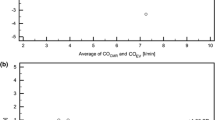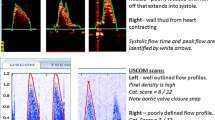Abstract
We evaluate the validity of cardiac index (CI) measurements utilizing the Ultrasonic Cardiac Output Monitor (USCOM), a non-invasive Doppler ultrasound device, by comparing measurements to cardiac catheterization-derived CI measurements in patients with single-ventricle physiology. USCOM measurements were repeated three times for each patient at the beginning of a cardiac catheterization procedure for twenty-six patients undergoing elective pre-Glenn or pre-Fontan catheterization. CI was measured by USCOM and was calculated from cardiac catheterization data using Fick’s method. Bland–Altman analysis for CI showed bias of 0.95 L/min/m2 with the 95% limits of agreement of − 1.85 and 3.75. Pearson’s correlation coefficient was 0.89 (p < 0.001) indicating a strong positive relationship between USCOM and cardiac catheterization CI measurements. When excluding two patients with significant dilation of the neo-aortic valve (z-score > + 5), the bias improved to 0.66 L/min/m2 with the 95% limits of agreement of − 1.38 and 2.70. Percent error of limits of agreement was 34%. There was excellent intra-operator reproducibility of USCOM CI measurements with an intra-class coefficient of 0.96. We demonstrate the use of USCOM to measure CI in patients with single-ventricle physiology for the first time, showing acceptable agreement of the CI measurements between USCOM and cardiac catheterization with a high intra-operator reproducibility.




Similar content being viewed by others
References
Bronicki RA (2016) Hemodynamic monitoring. Pediatr Crit Care Med 17(8 Suppl 1):S207–S214
Chang AC (2012) Determination of cardiac output in critically ill children: are we any closer to the ideal methodology? Pediatr Crit Care Med 13(1):99
Huygh J, Peeters Y, Bernards J, Malbrain ML (2016) Hemodynamic monitoring in the critically ill: an overview of current cardiac output monitoring methods. F1000Res 5:2855
Lemson J, Nusmeier A, van der Hoeven JG (2011) Advanced hemodynamic monitoring in critically ill children. Pediatrics 128(3):560–571
Mehta Y, Arora D (2014) Newer methods of cardiac output monitoring. World J Cardiol 6(9):1022–1029
Vincent JL, Rhodes A, Perel A, Martin GS, Della Rocca G, Vallet B et al (2011) Clinical review: update on hemodynamic monitoring—a consensus of 16. Crit Care 15(4):229
Saugel B, Thiele RH, Hapfelmeier A, Cannesson M (2020) Technological assessment and objective evaluation of minimally invasive and noninvasive cardiac output monitoring systems. Anesthesiology 133(4):921–928
Swan HJ, Ganz W (1983) Hemodynamic measurements in clinical practice: a decade in review. J Am Coll Cardiol 1(1):103–113
Alhashemi JA, Cecconi M, Hofer CK (2011) Cardiac output monitoring: an integrative perspective. Crit Care 15(2):214
Kobe J, Mishra N, Arya VK, Al-Moustadi W, Nates W, Kumar B (2019) Cardiac output monitoring: technology and choice. Ann Card Anaesth 22(1):6–17
Chandler HK, Kirsch R (2016) Management of the low cardiac output syndrome following surgery for congenital heart disease. Curr Cardiol Rev 12(2):107–111
Charpie JR, Dekeon MK, Goldberg CS, Mosca RS, Bove EL, Kulik TJ (2000) Serial blood lactate measurements predict early outcome after neonatal repair or palliation for complex congenital heart disease. J Thorac Cardiovasc Surg 120(1):73–80
USCOM Ltd (2006) USCOM 1A user manual. USCOM Ltd, Sydney
Critchley LA, Peng ZY, Fok BS, Lee A, Phillips RA (2005) Testing the reliability of a new ultrasonic cardiac output monitor, the USCOM, by using aortic flowprobes in anesthetized dogs. Anesth Analg 100(3):748–53 (table of contents)
Horster S, Stemmler HJ, Strecker N, Brettner F, Hausmann A, Cnossen J et al (2012) Cardiac output measurements in septic patients: comparing the accuracy of USCOM to PiCCO. Crit Care Res Pract 2012:270631
McNamara H, Barclay P, Sharma V (2014) Accuracy and precision of the ultrasound cardiac output monitor (USCOM 1A) in pregnancy: comparison with three-dimensional transthoracic echocardiography. Br J Anaesth 113(4):669–676
Su BC, Lin CC, Su CW, Hui YL, Tsai YF, Yang MW et al (2008) Ultrasonic cardiac output monitor provides accurate measurement of cardiac output in recipients after liver transplantation. Acta Anaesthesiol Taiwan 46(4):171–177
Tan HL, Pinder M, Parsons R, Roberts B, van Heerden PV (2005) Clinical evaluation of USCOM ultrasonic cardiac output monitor in cardiac surgical patients in intensive care unit. Br J Anaesth 94(3):287–291
Wong LS, Yong BH, Young KK, Lau LS, Cheng KL, Man JS et al (2008) Comparison of the USCOM ultrasound cardiac output monitor with pulmonary artery catheter thermodilution in patients undergoing liver transplantation. Liver Transpl 14(7):1038–1043
Aslan N, Yildizdas D, Horoz OO, Coban Y, Demir F, Erdem S et al (2020) Comparison of cardiac output and cardiac index values measured by critical care echocardiography with the values measured by pulse index continuous cardiac output (PiCCO) in the pediatric intensive care unit: a preliminary study. Ital J Pediatr 46(1):47
Beltramo F, Menteer J, Razavi A, Khemani RG, Szmuszkovicz J, Newth CJ et al (2016) Validation of an ultrasound cardiac output monitor as a bedside tool for pediatric patients. Pediatr Cardiol 37(1):177–183
van Lelyveld-Haas LE, van Zanten AR, Borm GF, Tjan DH (2008) Clinical validation of the non-invasive cardiac output monitor USCOM-1A in critically ill patients. Eur J Anaesthesiol 25(11):917–924
Cattermole GN, Leung PY, Mak PS, Chan SS, Graham CA, Rainer TH (2010) The normal ranges of cardiovascular parameters in children measured using the Ultrasonic Cardiac Output Monitor. Crit Care Med 38(9):1875–1881
He SR, Sun X, Zhang C, Jian Z, Sun YX, Zheng ML et al (2013) Measurement of systemic oxygen delivery and inotropy in healthy term neonates with the Ultrasonic Cardiac Output Monitor (USCOM). Early Hum Dev 89(5):289–294
He SR, Zhang C, Liu YM, Sun YX, Zhuang J, Chen JM et al (2011) Accuracy of the ultrasonic cardiac output monitor in healthy term neonates during postnatal circulatory adaptation. Chin Med J (Engl) 124(15):2284–2289
Doni D, Nucera S, Rigotti C, Arosio E, Cavalleri V, Ronconi M et al (2020) Evaluation of hemodynamics in healthy term neonates using ultrasonic cardiac output monitor. Ital J Pediatr 46(1):112
Nidorf SM, Picard MH, Triulzi MO, Thomas JD, Newell J, King ME et al (1992) New perspectives in the assessment of cardiac chamber dimensions during development and adulthood. J Am Coll Cardiol 19(5):983–988
Karpman VL (1975) The theoretical analysis of Fick’s equation. On the centennial of the use of Fick’s principle in physiology. Z Kardiol 64(9):801–8
Bergersen L (2009) The congenital cardiac catheterization manual. Springer, New York, pp x, 169
Seckeler MD, Hirsch R, Beekman RH 3rd, Goldstein BH (2014) Validation of cardiac output using real-time measurement of oxygen consumption during cardiac catheterization in children under 3 years of age. Congenit Heart Dis 9(4):307–315
Bland JM, Altman DG (1986) Statistical methods for assessing agreement between two methods of clinical measurement. Lancet 1(8476):307–310
Chong SW, Peyton PJ (2012) A meta-analysis of the accuracy and precision of the ultrasonic cardiac output monitor (USCOM). Anaesthesia 67(11):1266–1271
Critchley LA, Critchley JA (1999) A meta-analysis of studies using bias and precision statistics to compare cardiac output measurement techniques. J Clin Monit Comput 15(2):85–91
LaMantia KR, O’Connor T, Barash PG (1990) Comparing methods of measurement: an alternative approach. Anesthesiology 72(5):781–783
Mantha S, Roizen MF, Fleisher LA, Thisted R, Foss J (2000) Comparing methods of clinical measurement: reporting standards for Bland and Altman analysis. Anesth Analg 90(3):593–602
Peyton PJ, Chong SW (2010) Minimally invasive measurement of cardiac output during surgery and critical care: a meta-analysis of accuracy and precision. Anesthesiology 113(5):1220–1235
Bland JM, Altman DG (1994) Correlation, regression, and repeated data. BMJ 308(6933):896
Bland JM, Altman DG (1995) Comparing two methods of clinical measurement: a personal history. Int J Epidemiol 24(Suppl 1):S7-14
Bland JM, Altman DG (1996) Measurement error. BMJ 312(7047):1654
Bland JM, Altman DG (1999) Measuring agreement in method comparison studies. Stat Methods Med Res 8(2):135–160
Lu MJ, Zhong WH, Liu YX, Miao HZ, Li YC, Ji MH (2016) Sample size for assessing agreement between two methods of measurement by Bland–Altman method. Int J Biostat. https://doi.org/10.1515/ijb-2015-0039
Cecconi M, Rhodes A, Poloniecki J, Della Rocca G, Grounds RM (2009) Bench-to-bedside review: the importance of the precision of the reference technique in method comparison studies—with specific reference to the measurement of cardiac output. Crit Care 13(1):201
Fraga MV, Dysart KC, Rintoul N, Chaudhary AS, Ratcliffe SJ, Fedec A et al (2019) Cardiac output measurement using the ultrasonic cardiac output monitor: a validation study in newborn infants. Neonatology 116(3):260–268
Stewart GM, Nguyen HB, Kim TY, Jauregui J, Hayes SR, Corbett S (2008) Inter-rater reliability for noninvasive measurement of cardiac function in children. Pediatr Emerg Care 24(7):433–437
Brierley J, Peters MJ (2008) Distinct hemodynamic patterns of septic shock at presentation to pediatric intensive care. Pediatrics 122(4):752–759
Deep A, Goonasekera CD, Wang Y, Brierley J (2013) Evolution of haemodynamics and outcome of fluid-refractory septic shock in children. Intensive Care Med 39(9):1602–1609
Chaiyakulsil C, Chantra M, Katanyuwong P, Khositseth A, Anantasit N (2018) Comparison of three non-invasive hemodynamic monitoring methods in critically ill children. PLoS ONE 13(6):e0199203
Dey I, Sprivulis P (2005) Emergency physicians can reliably assess emergency department patient cardiac output using the USCOM continuous wave Doppler cardiac output monitor. Emerg Med Australas 17(3):193–199
Knirsch W, Kretschmar O, Tomaske M, Stutz K, Nagdyman N, Balmer C et al (2008) Cardiac output measurement in children: comparison of the ultrasound cardiac output monitor with thermodilution cardiac output measurement. Intensive Care Med 34(6):1060–1064
Nguyen HB, Banta DP, Stewart G, Kim T, Bansal R, Anholm J et al (2010) Cardiac index measurements by transcutaneous Doppler ultrasound and transthoracic echocardiography in adult and pediatric emergency patients. J Clin Monit Comput 24(3):237–247
Hatle L (1985) Assessment of aortic blood flow velocities with continuous wave Doppler ultrasound in the neonate and young child. J Am Coll Cardiol 5(1 Suppl):113S-S119
Funding
None.
Author information
Authors and Affiliations
Corresponding author
Ethics declarations
Conflict of interest
All authors declare that they have no conflict of interest.
Additional information
Publisher's Note
Springer Nature remains neutral with regard to jurisdictional claims in published maps and institutional affiliations.
Rights and permissions
About this article
Cite this article
Koh, W., Schneider, K.A., Zang, H. et al. Measurement of Cardiac Output Using an Ultrasonic Cardiac Output Monitor (USCOM) in Patients with Single-Ventricle Physiology. Pediatr Cardiol 43, 1205–1213 (2022). https://doi.org/10.1007/s00246-022-02840-0
Received:
Accepted:
Published:
Issue Date:
DOI: https://doi.org/10.1007/s00246-022-02840-0




